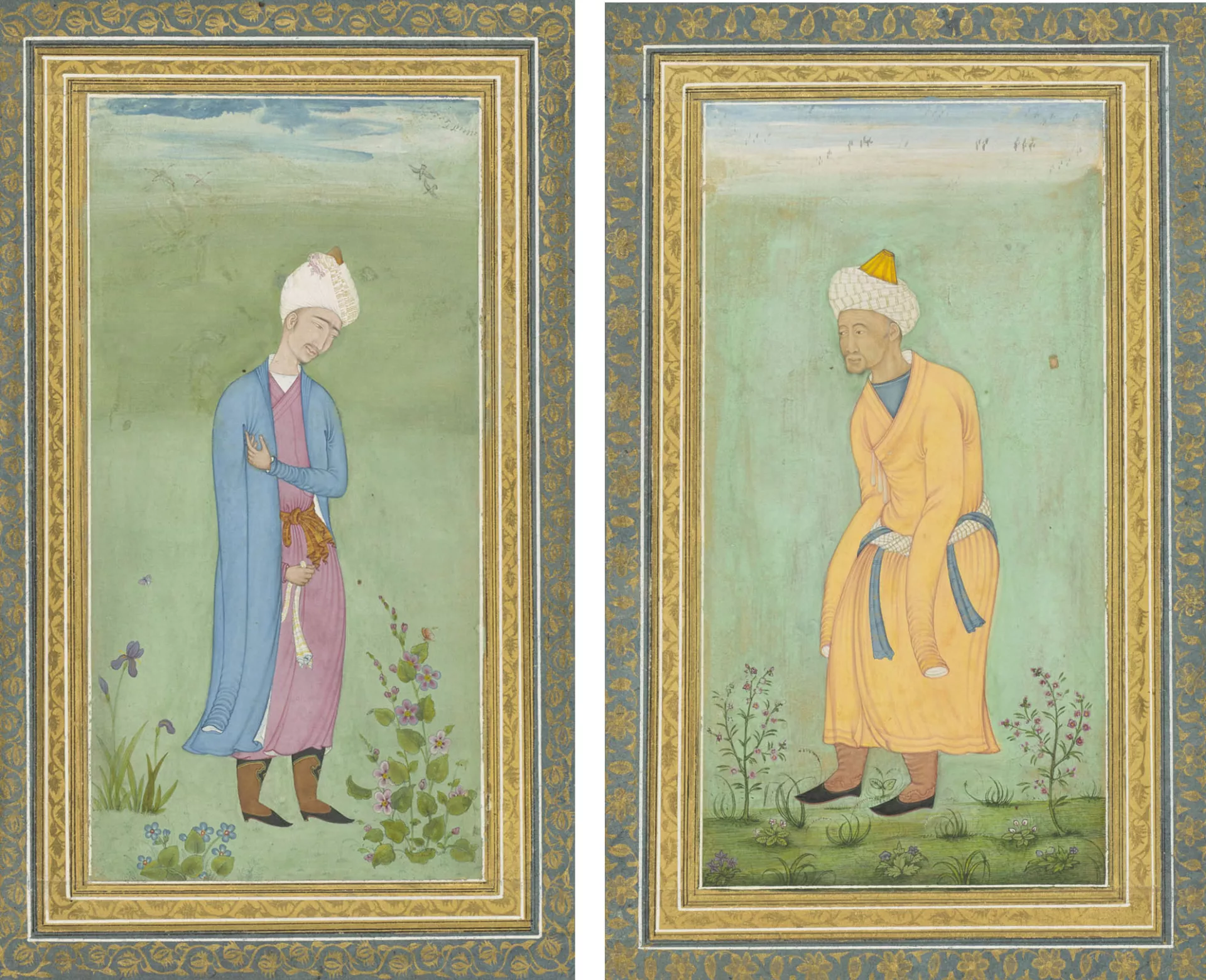
Eastern Encounters
Drawn from the Royal Library's collection of South Asian books and manuscripts
Abdullah Khan and his son Abd al-Mumin Khan
Mughal, <i>c</i>.1627Fols 32r and 33v from an album of Mughal portraits and calligraphy | Paintings in opaque watercolour including gold metallic paint; set into composite margins of dyed and plain papers with opaque watercolour and gold metallic ornament and ink inscription | 29.8 × 20.6 cm (folio); 13.6 × 6.8 cm (image) | RCINS 1005038.ae and 1005038.af
Abdullah Khan II (c.1534–98) (right) was the last Shaybanid ruler of Bukhara in Uzbekistan and Abd al-Mumin Khan (d. 1598) (left) his only son. Bukhara was part of the old Timurid heartland in Central Asia and its rulers maintained close diplomatic relations with the early Mughal emperors. Neither Abdullah Khan nor his son ever set foot in Hindustan and these portraits, commissioned by Jahangir, are testament to the Mughal Emperor’s desire to collect visual records of those known to him.[55] The portrait of Abd al-Mumin Khan with his graceful, slender figure and romantic stance is a copy after an earlier painting by an Iranian artist [56] while that of his father is likely to have been based on verbal description and painted to accompany it by a Mughal artist. Other portraits of Abdullah Khan were painted during Jahangir’s reign though not all share the same facial features.[57]
In a rare narrative account of Jahangir viewing portraits, Mutribi Samarqandi, a Central Asian poet who visited his court at Lahore in 1627, recorded a conversation with the Emperor in which he was asked to comment on portraits of Abdullah Khan and his son, whom he had known, and to point out changes that should be made in order to make them more accurate:
The Emperor had a painting in his hand and was studying it. He called me forward, and told me, ‘Look at this painting. Do you know whose portrait it is?’
When I looked I saw that one was a portrait of Abdullah Khan Uzbek and another was of Abd al-Mumin Khan. ‘Are these good likenesses,’ he asked me, ‘or do you have some comments to make? If you do, then tell me.’
‘The portrait of Abdullah Khan is too fleshy, and his chin was not as straight as it’s shown here,’ I replied. ‘In fact he was rather thin, and he had a crooked chin.’
‘Was it crooked on the right side, or the left?’ he asked.
‘On the left’, I said.
A painter was called out to correct the portrait, and whatever I said he was ordered to make the appropriate changes. Then the Emperor asked, ‘What about the portrait of Abd al-Mumin Khan?’ ‘He’s painted very greenish here,’ I said. ‘He wasn’t like that; in fact he was more white than green, and he wore his turban a little more to the front, as neatly as possible.’
‘Take off your turban,’ he said, ‘and show me how he did it.’
I took off my turban and showed him. The Emperor said to the painter, ‘Paint it this way.’ The next day the painter brought out the paintings just the way I had said they should be.[58]
In cartouches:
abdullah khan-e uzbek / Abdullah Khan, the Uzbek
abd al-mumin khan khalaf-e abdullah khan / Abd al-Mumin Khan, successor of Abdullah Khan
[55] Other depictions of foreign rulers by Mughal artists dating to Jahangir’s reign include portraits of Malik Amber of Ahmadnagar and Sultan Muhammad Qutub Shah of Golconda by Hashim, c.1624–5, both in the Minto Album, V&A IM.21-1925 and IM.22-1925.
[56] The original portrait of Abd al-Mumin Khan is in the so-called Nasir al-Din Shah Album (GPL MS 1639) facing an image of Khodabanda Mirza, father of Shah Abbas I, by Bishandas, rather than his father as here. See Godard 1938, pp. 248–9 and Rajabi ed. 2005, p. 490. The artist could credibly be identified as Aqa Reza. See 'A gardener' by Aqa Reza in E. Binny 1973, 3rd Collection of the San Diego Museum of Art, Acc. no. 1990.314.
[57] See V&A IM.20-1925, BM 1948,1211,0.10 and BM 1920,0917,0.13.
[58] Samarqandi 1998 (slightly edited translation), pp. 76–7.








